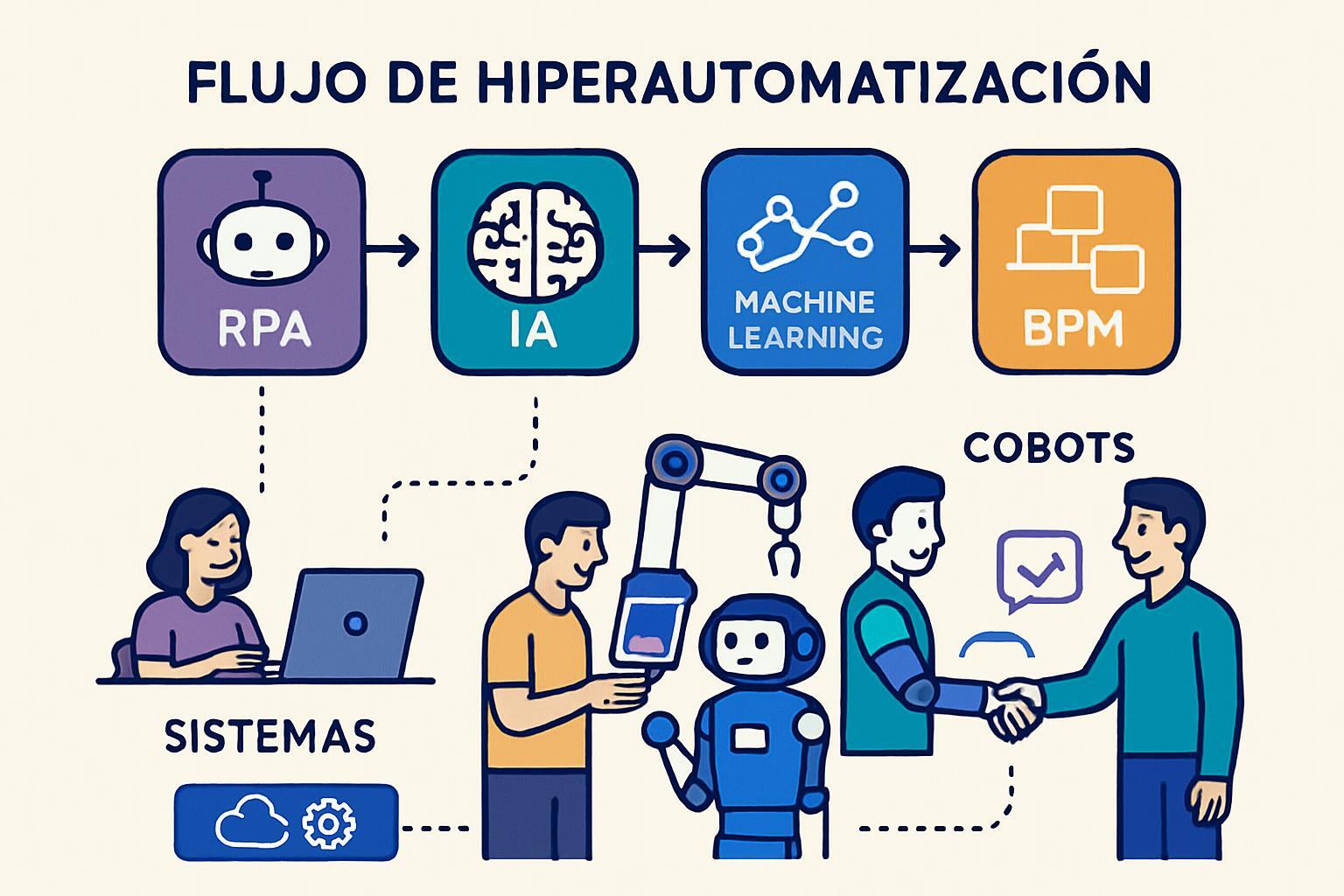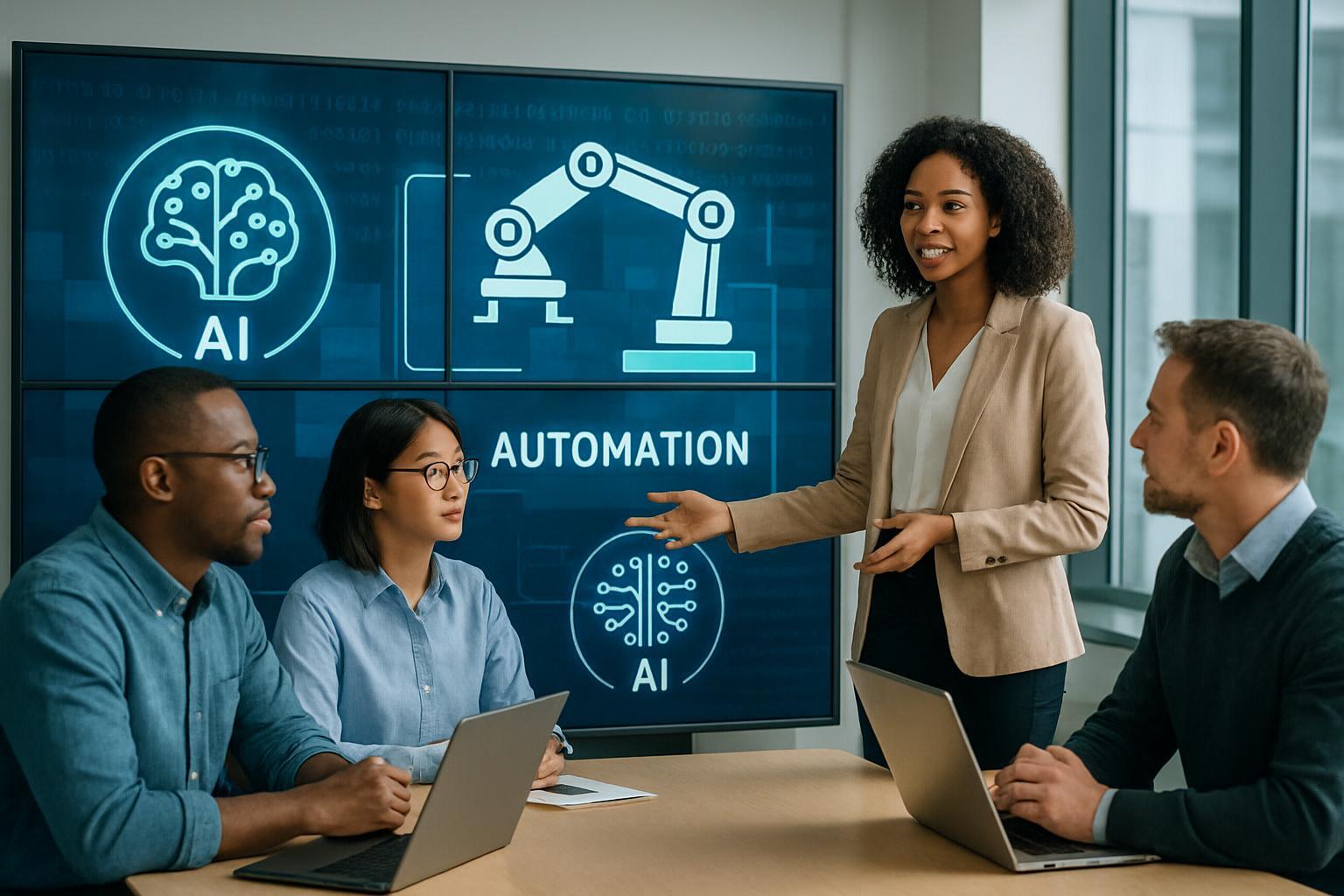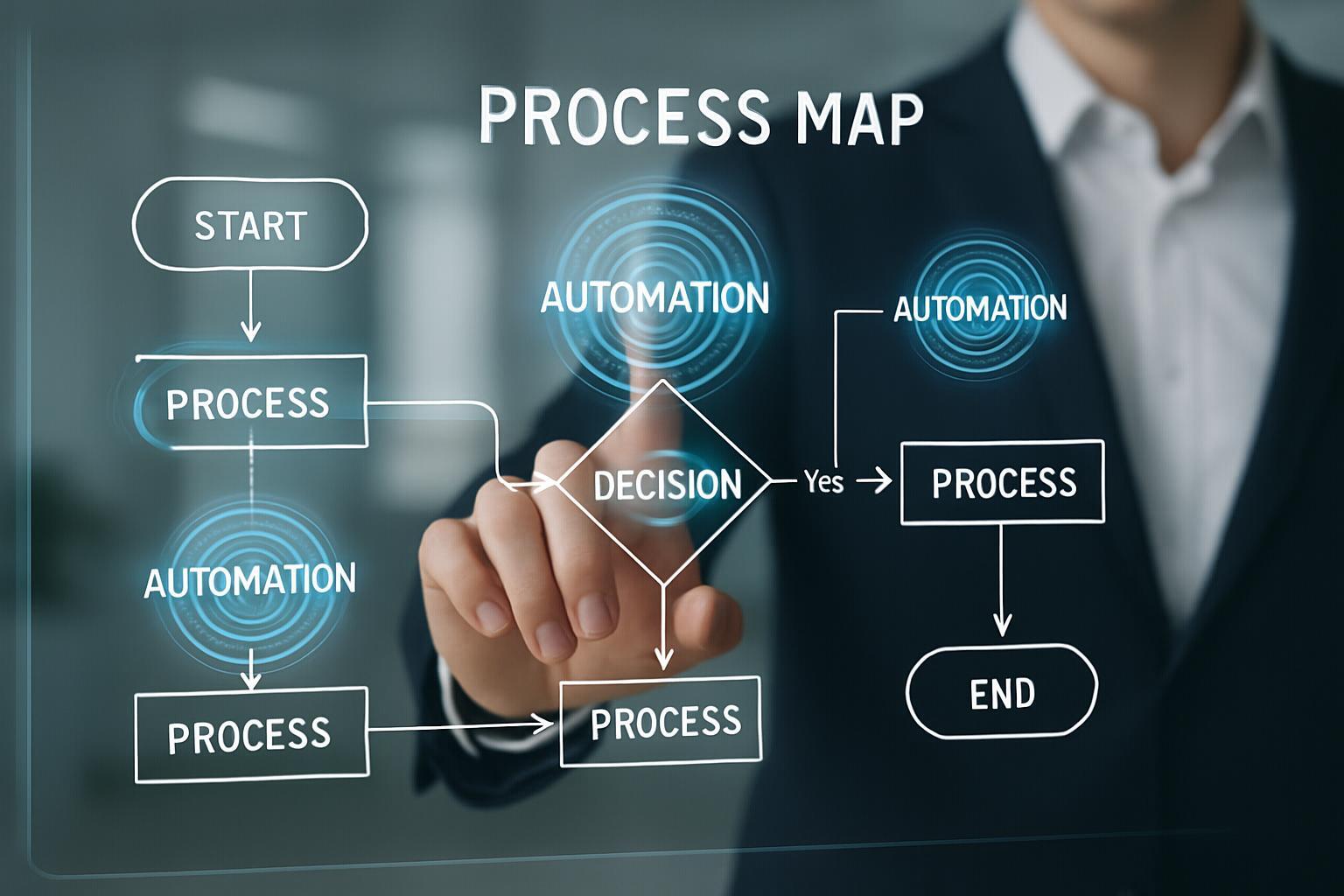AI-powered business automation is the deciding factor that will determine which companies will thrive in the new economic landscape of 2025. Organizations implementing intelligent automation solutions are experiencing productivity increases of up to 40% and reductions in operating costs reaching 30%, radically transforming their business models.
Companies that leverage the potential of automation not only improve their financial results but also free up human talent for tasks of greater strategic value. This integrated approach is redefining competitiveness in virtually all economic sectors.
Key Technologies Driving Business Automation in 2025
The technological ecosystem supporting business process automation is evolving rapidly, integrating diverse solutions that, together, offer transformative capabilities:
Hyperautomation: The Decisive Technological Convergence
Hyperautomation represents the strategic integration of RPA, AI, machine learning, and BPM (Business Process Management), creating an environment where processes are continuously optimized. By 2025, 70% of global companies will have adopted this approach, according to recent projections.
Hyperautomation systems are capable of analyzing more than 1.5 TB of daily operational data to detect inefficiencies and coordinate up to 15 business systems simultaneously, allowing for unprecedented workflow orchestration.
Generative AI (GenAI)
Generative AI is revolutionizing predictive decision-making in business environments. 50% of organizations already implement GenAI to optimize complex workflows, from content creation to process design. Its analytical capacity reduces strategic analysis times by an impressive 60%.
This technology not only executes repetitive tasks but creates adaptive solutions that evolve with the needs of the business, significantly increasing productivity by automating routine decisions.
Industrial IoT and Edge Computing
The massive implementation of IoT sensors (with 40 million new devices projected for 2025) generates a real-time operational data infrastructure that feeds predictive automation systems.
In the manufacturing sector, this technology reduces downtime by 35% through preventive maintenance, while edge computing processes 60% of this data locally, reducing latency in critical decisions from 200ms to just 5ms.
Collaborative Robotics (Cobots)
Cobots will represent 30% of investment in industrial automation by 2025. These collaborative robots stand out for their precision (±0.02mm tolerances in micro-manufacturing operations), safe interaction with humans, and ability to be quickly reconfigured, adapting to new production lines in less than 24 hours.

Quantifiable Benefits: Productivity and Cost Savings
The strategic implementation of intelligent automation generates measurable benefits that directly impact business results:
Significant Increase in Productivity
Organizations that implement automation solutions experience average reductions of 52% in operational cycles, a 67% decrease in human errors, and 38% increases in production capacity. These benefits translate into a greater ability to meet market demands with existing resources.
A concrete example: a global bank implemented RPA bots with natural language processing for loan management, managing to reduce approval times by 50% (from 14 to 7 days) and decrease documentary errors by 70%.
Substantial Reduction in Operating Costs
The average return on investment (ROI) in automation projects is 3:1 in the first 18 months. Direct savings include:
- 25-30% in back-office costs, optimizing administrative processes
- 15-20% in manufacturing expenses, improving production efficiency
- 40% in audit times, facilitating regulatory compliance
- 35% in excess inventory through AI-driven demand prediction
These economic benefits allow resources to be reallocated to strategic initiatives that drive growth, instead of being allocated to routine operations.
Success Stories in Various Sectors
AI-powered business automation is transforming entire industries, as these case studies demonstrate:
Financial Sector: Intelligent Credit Processing
An international financial institution implemented an advanced RPA solution that integrates 18 internal and external systems, automatically validating credit data against tax records and global databases.
Result: an annual savings of $4.2 million in operating costs and a radically improved customer experience, with credit decisions made in half the time previously required.
Healthcare Sector: AI-Assisted Triage
A tertiary hospital in Madrid implemented an artificial intelligence system capable of analyzing 5,000 medical images daily with 98.7% accuracy, reducing diagnosis times by 40%.
The system automatically prioritizes critical cases, which has helped improve the survival rate in emergencies by 22%. Additionally, its integration with electronic health records allows for the prediction of postoperative complications.
Manufacturing: Smart Factories with Digital Twins
A German automotive plant developed digital twins capable of simulating 350 production scenarios per minute to optimize its production lines.
These predictive models identify equipment failures 15 days in advance (95% accuracy) and reduce energy consumption by 18% through dynamic adjustments. The result: an increase in annual production of 120,000 units without increasing fixed costs.
Challenges in Implementation and Strategies to Overcome Them
Despite its benefits, business process automation presents significant challenges that organizations must proactively address:
Technical Skills Gap
68% of companies report a shortage of qualified personnel to operate advanced automation systems. Leading organizations are responding with:
- Upskilling programs: immersive 120-hour courses that increase technical competence by 75%
- Academic partnerships: specialized bootcamps that train 15,000 technicians per year in AI technologies
- Internal mentoring: programs where experienced personnel transfer knowledge to new teams
Integration with Legacy Systems
45% of automation projects fail due to incompatibility with legacy infrastructure. Effective strategies include:
- Implementation of adaptation middleware: APIs that connect obsolete systems with modern platforms
- Gradual migration: implementation by modules with incremental ROI (6-9 months per phase)
- Microservices-oriented architecture that facilitates progressive integration
Data Quality and Governance
60% of AI models exhibit bias due to insufficient or corrupted data. To mitigate this risk, companies are implementing:
- Unified data lakes: centralized repositories that process 2.5 PB of purified data daily
- Sanitation algorithms: 80% reduction in irrelevant data using NLP techniques
- Multidisciplinary data governance teams that establish quality standards

The Role of AI as a Catalyst for Automation
Artificial intelligence acts as the brain that powers modern automation systems, providing capabilities that transcend traditional possibilities:
Advanced Cognitive Automation
Current AI-based systems significantly surpass human capabilities in:
- Document processing: 8,000 pages per hour versus the 40 pages a human employee would process
- Anomaly detection: identifying patterns in 12 simultaneous dimensions
- Mass personalization: generating 50,000 product variants daily based on customer preferences
Predictive Analytics for Continuous Optimization
Machine learning models allow organizations to:
- Achieve 94% accuracy in demand forecasts at 90 days
- Evaluate 200 different business scenarios in just 10 minutes
- Reduce logistics costs by 30% through intelligent and dynamic routes
These analytical capabilities transform decision-making, moving from reactive approaches to proactive strategies based on predictive data.
Implementing Automation: Key Steps for Success
To maximize the benefits of AI-powered business automation, organizations must follow a structured approach:
1. Strategic Process Evaluation
Before automating, it is essential to identify the processes that will offer the greatest impact. A detailed analysis should consider:
- Volume and frequency of tasks
- Complexity and variability of processes
- Strategic value vs. implementation effort
- Potential for time savings and error reduction
2. Technology Selection Aligned with Objectives
Not all technologies are suitable for every use case. Companies should evaluate:
- Compatibility with existing infrastructure
- Scalability for future growth
- Ease of integration with other systems
- Total cost of ownership (TCO) and expected return
3. Iterative Implementation and Constant Measurement
The most effective approach is iterative, starting with pilot projects that generate learnings applicable on a larger scale:
- Start with processes of medium complexity and high impact
- Establish clear performance metrics before and after automation
- Constantly adjust based on real operational data
- Gradually scale to more complex processes
The Future of Automation: Emerging Trends Towards 2030
Business automation will continue to evolve towards increasingly autonomous and integrated ecosystems:
Augmented Decision-Making Autonomy
It is projected that by 2030, 40% of strategic decisions in organizations will be proposed or made directly by AI systems, revolutionizing business management models.
Comprehensive Management Through Digital Twins
Digital twins will manage 75% of corporate physical assets, creating complete virtual representations that allow for advanced simulations and predictive maintenance with unprecedented accuracy.
Integrated Ethical Frameworks
Algorithmic ethics will be natively incorporated into 90% of automation platforms, reflecting a commitment to transparency and responsibility in automated decision-making.
Advanced Conversational Interfaces
Human-machine interaction will evolve towards fully conversational interfaces, where employees without technical knowledge will be able to configure and direct complex automation systems using natural language.
Conclusion: Preparing Your Company for the Automation Revolution
AI-powered business automation represents much more than an incremental optimization of processes: it constitutes a fundamental redefinition of how organizations operate. Companies that strategically integrate these technologies will not only reduce costs and increase their productivity, but will gain a sustainable competitive advantage.
Success in this new paradigm requires a balanced approach between technology and human talent. Organizations must invest both in advanced technological platforms and in the development of their personnel's skills to make the most of the potential of automation.
Those companies that begin their transformation now will be better positioned to lead their respective sectors in 2025 and beyond, capitalizing on the extraordinary opportunities offered by the convergence of artificial intelligence and business automation.


